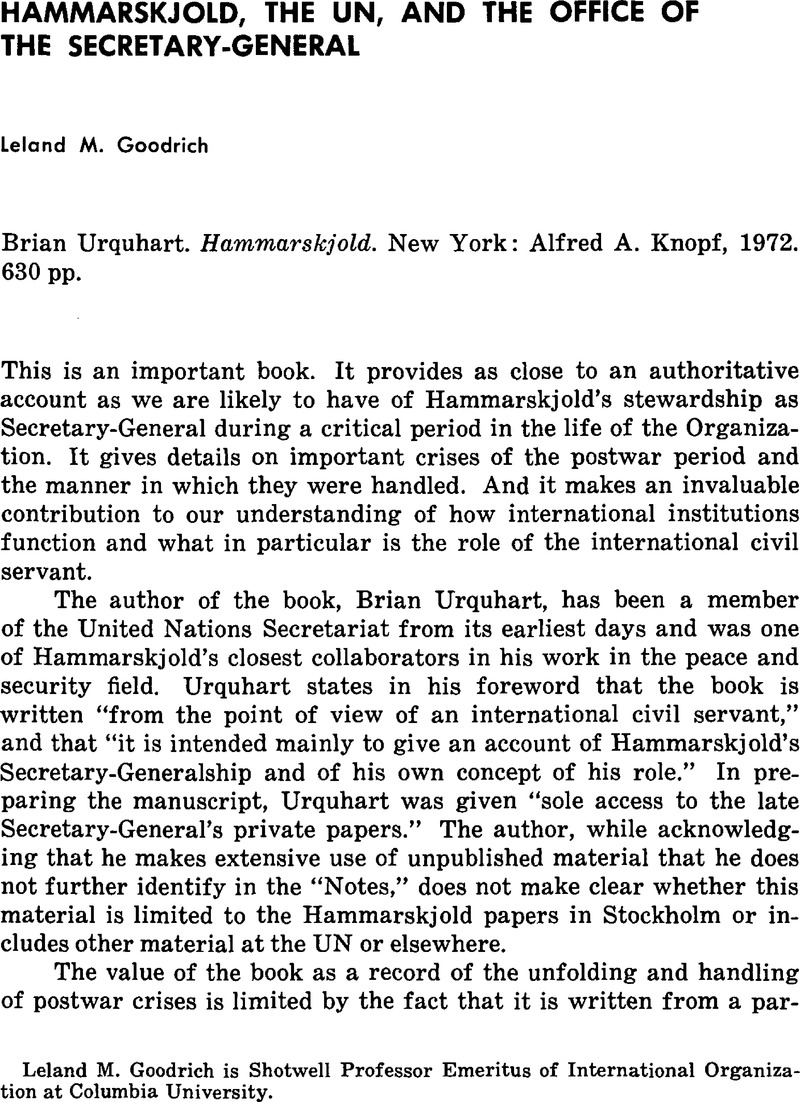Article contents
Hammarskjold, the UN, and the Office of the Secretary-General
Published online by Cambridge University Press: 22 May 2009
Abstract

- Type
- Review Essays
- Information
- Copyright
- Copyright © The IO Foundation 1974
References
1 For example, Anthony, Eden, Full Circle: The Memoirs of Anthony Eden (Boston: Houghton Mifflin, 1960Google Scholar); Anthony, Nutting, No End of a Lesson: The Story of Suez (New York: C. N. Potter, 1967Google Scholar); Eisenhower, Dwight D., The White House Years: Waging Peace, 1956–61 (New York: Doubleday and Co., 1965Google Scholar); and Pearson, Lester B., Mike, The Memoirs of the Right Honourable Lester B. Pearson (Toronto: Quadrangle, 1972).Google Scholar
2 Rovine, Arthur W. has given us a useful detailed study of the League and UN Secretaries-General in his The First Fifty Years: The Secretary General in World Politics, 1920–1970 (Leyden: A. W. Sijthoff, 1970).Google Scholar
3 Urquhart, p. 46.
4 For texts of early statements, see Wilder, Foote, ed., Servant of Peace: A Selection of the Speeches and Statements of Dag Hammarskjold (New York: Harper & Row, 1962Google Scholar); and Andrew, Cordier and Wilder, Foote, eds., Public Papers of the Secretaries-General of the United Nations, 2 vols. (New York: Columbia University Press, 1972Google Scholar), vol. 2.
5 Quoted in Urquhart, p. 46, and Cordier and Foote, vol. 2, p. 468.
6 For text, see Foote, pp. 251–60.
7 General Assembly Official Records (16th session), Supplement No. 1A (A/4800/Add. 1).
8 Urquhart, p. 47.
9 Ibid., p. 370.
10 Ibid., p. 595. For a more extensive analysis of his thinking, see Zacher, Mark W., Dag Hammarskjold's United Nations (New York: Columbia University Press, 1970).Google Scholar
11 Trygve, Lie, In the Cause of Peace (New York: The Macmillan Co., 1954), pp. 420–21.Google Scholar
12 UN Document A/8401/Add. 1 (17 September 1971), p. 53.
13 Urquhart, pp. 22–26.
14 Quoted in ibid., p. 54, and Codier and Foote, vol. 1, p. 34.
15 Urquhart, p. 527.
16 Ibid., p. 61.
17 For an objective but sympathetic exposition of Hammarskjold's handling of the 1953 personnel crisis, see ibid., pp. 66–70. For a critical review, see Shirley, Hazzard, Defeat of an Ideal (Boston: Little, Brown and Co., 1973), pp. 52–69.Google Scholar
18 Report of the Preparatory Commission of the United States, PC/20, 23 December 1945, p. 85.
19 Urquhart, pp. 525–28. For a full statement of Hammarskjold's views, see his Oxford University lecture of 30 May 1961 in Foote, pp. 329–49.
20 Conor, Cruise O'Brien, To Katanga and Back (New York: Simon and Schuster, 1962), p. 55.Google Scholar
21 Jean, Siotis, Essai sur le Secretariat International (Geneva: Libraire Droz, 1963), pp. 241–52.Google Scholar
22 Foote, p. 27.
23 See Urquhart, pp. 94–131; and Joseph, Lash, Dag Hammarskjold (New York: Doubleday and Co., 1961), pp. 56–65.Google Scholar
24 Urquhart, p. 178; and Pearson, Memoirs, vol. 2, p. 247.
25 Urquhart, p. 174.
26 See Urquhart, p. 242, quoting from Hammarskjold's Annual Report for 1956–57.
27 General Assembly Official Records, 825th meeting, paragraph 86, as given in Foote, p. 150.
28 Quoted in Urquhart, pp. 255–56. (Ellipses in original.)
29 General Assembly Official Records (15th session), Supplement No. 1A, p. 4.
30 Leon, Gordenker, The UN Secretary-General and the Maintenance of Peace (New York: Columbia University Press, 1967), pp. 137–58.Google Scholar
31 For Hammarskjold's detailed justification, see his Oxford University lecture in Foote, pp. 329–53.
32 Urquhart, p. 596.
33 See Phelan, E. J., Yes and Albert Thomas (London: Cresset Press, 1936).Google Scholar
- 1
- Cited by




